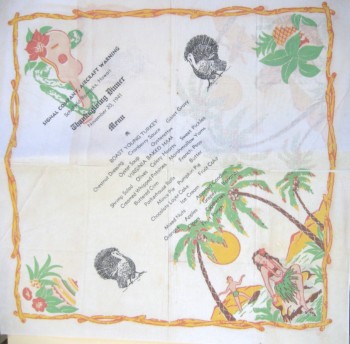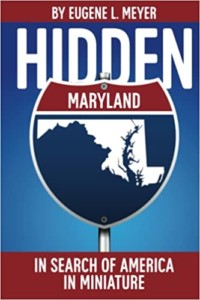Let’s Remember Pearl Harbor
Dec. 7, 1941, “a date which will live in infamy,” 81 years ago, is little remembered.
But it still resonates, along with Sept. 11, 2001, and Jan. 6, 2021, as days when our democracy, indeed our very national existence, came under attack. Some years ago, I acquired a remarkable napkin from the Thanksgiving meal held at Scofield Barracks just three weeks before the Japanese attack on Pearl Harbor. For Thanksgiving six years ago, I blogged about it and am reposting it here.
November 23, 2016:

Three score and 15 years ago, our country was deeply divided. There were the isolationists and the interventionists, the former insisting on an America First that turned its back on the rest of the world, the latter deeply concerned about the rise of totalitarian regimes abroad and their threat to democracy at home.
That was our country on Thanksgiving 1941. Less than three weeks later, in an instant, everything changed, and nothing, it seemed, would ever be the same again. Sometimes, it takes a cataclysmic event to bring us together. Remember the Maine? Of course not. Remember Pearl Harbor? Perhaps. Remember 9/11? Most certainly.
It is the calm before the storm that we also recall in retrospect. That beautiful clear morning pf 9/11 with the bluest of blue skies over Manhattan—and at the Pentagon.
On Sunday of December 7, 1941, Washington’s professional football team was defeating the Philadelphia Eagles at old Griffith Stadium by a score of 20 to 14. All seemed well, but the victory was soon overshadowed by the Japanese attack on Pearl Harbor and U.S. entry into World War II.
President Franklin Delano Roosevelt called it “a date which will live in infamy,” but infamy doesn’t always last. Unless, perhaps, an artifact suddenly appears to remind us. It was the rarest of finds: a Thanksgiving napkin menu from Signal Company, Aircraft Warning, Schofield Barracks, Hawaii. The date: Nov. 20, 1941. Seventeen days later, Schofield was strafed by Japanese aircraft headed for the U.S. Pacific Fleet at Pearl Harbor.
This 13 1/2-inch square napkin was folded inside a loose-leaf binder of paper ephemera in a Western Maryland antique shop when I acquired it for $2 (reduced from $5). But, of course, it is priceless. And here we are, 75 years on.
It was that same day, Nov. 26, 1941, when FDR signed a bill officially designating the fourth Thursday in November as Thanksgiving.
The United States was celebrating its last peacetime Thanksgiving for four years. One can only surmise what it must have been like as the Signal Company, Aircraft Warning chowed down at Schofield Barracks. Before them was a veritable feast, a last supper.
The diamond-shaped napkin includes idyllic if dated images: a woman in a grass skirt and lei, the smaller figure of a male surfer in the background, both under palm trees and sun; a ukulele, a pineapple, turkeys. Then an all-American menu with everything from soup (oyster) to nuts (mixed), plus roast young turkey, chestnut dressing, cranberry sauce, giblet gravy, Virginia baked ham, shrimp salad, creamed whipped potatoes, marshmallow yams, Parker house rolls, mince pie, pumpkin pie, chocolate layer cake, fruit cake, ice cream, assorted candies, oranges, apples, grapes, bananas, cigars, cigarettes, and, to wash it all down, fruit punch.
The squadron would be Pearl’s initial line of defense. Its job would be to sound the first alarm of any imminent attack, and that Thanksgiving was more than turkey day at Schofield. It was also when the Aircraft Warning squadron moved radar equipment to the top of a hill overlooking the Pacific. At 7:02 a.m. on Dec. 7, radar spotted more than 50 planes. The operator who phoned in a report was told it was likely a fleet of B-17 Flying Fortresses from San Francisco. The Japanese went on to Pearl Harbor, which became a watery grave for 3,000 Americans, as the Al Qaida attacks would take nearly 3,000 lives three generations later.
As pre-Pearl America was emerging from the shadow of the Great Depression and barely paying attention to world events, pre-9/11 America was poised to continue as the world’s remaining superpower on the optimistic path of peace and prosperity. In the near future, the optimism would be shattered by wars in Iraq and Afghanistan, the Great Recession, more frequent extreme weather events linked to climate change, an unprecedented refugee crisis.
In both eras, a great nation was oblivious to dangers it should have foreseen. Now, all we can do is memorialize the dead. Sept. 11, 2011 was a national day of sadness, as so should be Dec. 7. But let today be a day of thanksgiving, and a day to reaffirm our country’s core principles, enunciated by FDR, a month after attack, as the Four Freedoms: Freedom of Speech and Expression, Freedom of Worship, Freedom from Want, Freedom from Fear. They, too, are worth remembering, and fighting for, and not just overseas.
I prefaced the post with this; the second, aspirational paragraph still seems relevant:
I first published this post two years ago, for Thanksgiving — less than three weeks before the 75th anniversary of the attack on Pearl Harbor, marking Dec. 7, 1941, forever, FDR proclaimed in asking Congress for a declaration of war against Japan, as “a date which will live in infamy.” The blog ran shortly after the 2016 presidential election, and some of it still applies to the current state of our union. In the name of “America First,” policies have been announced or implemented that threaten our liberties and indeed the very future of the entire world.
Yet, as the country turns a page into the New Year of 2019, we still hold out hope that these truths remain self-evident, that, as Lincoln said at Gettysburg in 1863, “this nation, under God, shall have a new birth of freedom and that government of the people, by the people, for the people shall not perish from the earth.”
History Conversations. Tune in next Tuesday.
Join me for a Zoom webinar for an inside look at his new book “Hidden Maryland: In Search of America in Miniature” at 2 p.m. on Tuesday, Dec. 13, as part of the Montgomery County Historical Society’s (AKA Montgomery History) “History Conversations” series. To learn more (and to register, for free), click here . In Hidden Maryland: In Search of America in Miniature, and in History Conversations, I share some of my favorite off-the-beaten path places. Henry Allen, the fabled former Post Style section editor, once dubbed me Mr. Maryland. James Bready, of the Baltimore Sun, once deemed me “our very own Marco Polo.” In Hidden Maryland, I hope to have earned both titles. To order the book, click here. If you like it, please rate and review it on Amazon. Thanks!
See you on Zoom!

Stolen Silver: Nazi Plunder and the Unfinished Quest for Restitution
Check out the new issue of B’nai B’rith Magazine with a remarkable cover story on efforts to recover items the Nazis stole from Austrian and German Jews in 1939 and the renewed efforts to return them to their rightful owners or heirs. One of the heirs turned out to be a longtime family friend and neighbor whose boys grew up with ours in Silver Spring, Maryland. At dinner one night at her home she told the story, and bingo! My wife Sandra said it sounds like a story for your magazine (of which I’ve been the editor since December 2009). I knew just the reporter for it: Dina Gold, whose book Stolen Legacy, also adapted for our magazine in 2019, told of her own efforts to obtain reparations for a commercial building and business in Berlin the Nazis seized from her family. Dina rose to the challenge, and items belonging to many of the families — including our friend’s family’s silver cup — have been or are being restituted.
